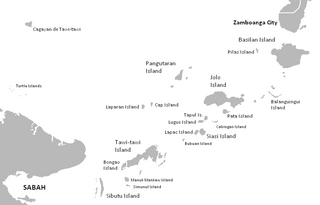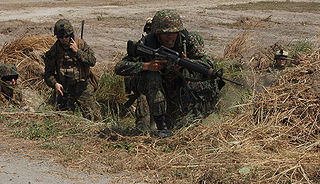
The Moro Islamic Liberation Front is a group based in Mindanao seeking an autonomous region of the Moro people from the central government. The group has a presence in the Bangsamoro region of Mindanao, the Sulu Archipelago, Palawan, Basilan, and other neighbouring islands. The armed wing of the group was the Bangsamoro Islamic Armed Forces (BIAF), although the name of its parent organization, the MILF, was often used to refer to the BIAF. In July, 2018, the Philippine government passed the Bangsamoro Organic Law, giving more autonomy to Muslims. In return, MILF announced that it would disarm its 30,000 fighters.

The Sulu Archipelago is a chain of islands in the Pacific Ocean, in the southwestern Philippines. The archipelago forms the northern limit of the Celebes Sea and southern limit of the Sulu Sea. The Sulu Archipelago islands are within the Mindanao island group, consisting of the provinces of Basilan, Sulu, and Tawi-Tawi; hence the archipelago is sometimes referred to as Basulta, derived from the first syllables of the three provinces.

Operation Enduring Freedom – Philippines (OEF-P) or Operation Freedom Eagle was part of Operation Enduring Freedom and the global War on Terror. The Operation targeted the various Jihadist terror groups operating in the country. By 2009, about 600 U.S. military personnel were advising and assisting the Armed Forces of the Philippines (AFP) in the Southern Philippines. In addition, by 2014, the CIA had sent its elite paramilitary officers from their Special Activities Division to hunt down and kill or capture key terrorist leaders. This group had the most success in combating and capturing Al-Qaeda leaders and the leaders of associated groups like Abu Sayyaf.

Jolo is a volcanic island in the southwest Philippines and the primary island of the province of Sulu, on which the capital of the same name is situated. It is located in the Sulu Archipelago, between Borneo and Mindanao, and has a population of approximately 500,000 people.

The Moro conflict is an insurgency in the Mindanao region of the Philippines, which has involved multiple armed groups, and has been ongoing since March 1968. Peace deals have been signed between the Philippine government and two major armed groups, the Moro National Liberation Front (MNLF) and the Moro Islamic Liberation Front (MILF), but other smaller armed groups continue to exist.

The First Battle of Bud Dajo, also known as the Moro Crater Massacre, was a counterinsurgency action fought by the United States Army against Moros in March 1906, during the Moro Rebellion in the southwestern Philippines. Whether the occupants of Bud Dajo were hostile to U.S. forces is disputed, as inhabitants of Jolo Island had previously used the crater, which they considered sacred, as a place of refuge during Spanish assaults. Major Hugh Scott, the District Governor of Sulu Province, where the incident occurred, recounted that those who fled to the crater "declared they had no intention of fighting, - ran up there only in fright, [and] had some crops planted and desired to cultivate them."

Cardozo Manalo Luna is a retired three-star general and the 35th Vice Chief of Staff of the Armed Forces of the Philippines. Cardozo Luna also served as the commander of two unified commands, Eastern Mindanao Command and Central Command. He served as the Philippine Ambassador to The Hague, Netherlands from 2009 until 2010 He is the current Undersecretary of Department of National Defense.

The Jabidah massacre on March 18, 1968 was the purported assassinations or executions of Moro army recruits who allegedly mutinied upon learning the true nature of their mission. It is acknowledged as a major flashpoint that ignited the Moro insurgency in the Philippines.

Benito Antonio Templo de León is a retired military officer of the Armed Forces of the Philippines (AFP). While a Roman Catholic, he was conferred the rare Muslim-Maranao honorary title of Sultan a Romapunut for his peace efforts. De León held the Army rank of major general and was the commander of the Philippine Army 5th Infantry Division until his designation as Inspector General of the Armed Forces of the Philippines. He retired in 2016 after reaching the mandatory retirement age of 56.

Delfin C. Castro was a major general of the Armed Forces of the Philippines. He was the commander of the AFP Southern Command (SOUTHCOM), from 1981 to 1986. Notable incidents during his tenure include the Pata Island massacre, the assassination of Zamboanga City Mayor Cesar Climaco, the rescue of kidnapped Bishop Federico O. Escaler from Muslim rebels and the strafing of the Japanese vessel Hegg by Philippine Air Force fighters off Mindanao.

Bangsamoro, officially the Bangsamoro Autonomous Region in Muslim Mindanao, is an autonomous region in the Philippines, located in the southwestern portion of the island of Mindanao.

Emmanuel Trinidad Bautista is a Filipino general who served as the 44th Chief of Staff of the Armed Forces of the Philippines as he succeeded Gen. Jessie Dellosa as AFP Chief. He served as the Executive Director of the Cabinet Cluster on Security, Justice, and Peace at the Office of the President, Malacañang. His appointment as Undersecretary at the Office of the President was from 1 September 2014 to 22 June 2020 shortly after retirement from the military service as Chief of Staff, Armed Forces of the Philippines. Concurrently, he headed the National Task Force on the Whole of Nation Initiative and was also the executive Director of the National Task Force on the West Philippine Sea. He was succeeded by Gregorio Pio Catapang as AFP chief.

The Zamboanga City crisis or Zamboanga Siege was an armed conflict in Zamboanga City, Philippines between the government forces of the Philippines and Moro rebels from the Moro National Liberation Front (MNLF) that began on September 9, 2013 and ended twenty days later on September 28. The conflict began when MNLF rebels, under the command of Nur Misuari, attempted to occupy several coastal communities in Zamboanga City in protest of the Philippine government's failure to implement the 1996 final peace agreement with the MNLF.
The Malisbong Masjid or H. Hamsa Tacbil Mosque massacre, also called the Palimbang massacre, was the mass murder of Muslim Moros by units of the Philippine military on September 24, 1974, in the coastal village of Malisbong in Palimbang, Sultan Kudarat, Mindanao. Accounts compiled by the Moro Women's Center in General Santos City state that 1,500 male Moros aged 11–70 were killed inside a mosque, 3,000 women and children aged 9–60 were detained – with the women being raped – and that 300 houses were razed by the government forces. The massacre occurred two years after Ferdinand Marcos declared martial law in September 1972.
The Mamasapano clash was a shootout that took place during a police operation by the Special Action Force (SAF) of the Philippine National Police (PNP) on January 25, 2015, in Tukanalipao, Mamasapano, then-undivided Maguindanao. The operation, codenamed Oplan Exodus, was intended to capture or kill wanted Malaysian terrorist and bomb-maker Zulkifli Abdhir and other Malaysian terrorists or high-ranking members of the Moro Islamic Liberation Front (MILF).

The Patikul massacre refers to an event that took place on October 10, 1977 in Patikul, Sulu province in the Philippines. Thirty-five officers and men of the Philippine Army were killed by elements of the Moro National Liberation Front under Usman Sali. Among the dead were Brigadier General Teodulfo Bautista, commanding general of the 1st Infantry Division, Adjutant General of the Armed Forces of the Philippines, Col. Gabriel Pangilinan and four lieutenant colonels.

The Maute group, also known as the Islamic State of Lanao, was a radical Islamist group composed of former Moro Islamic Liberation Front guerrillas and foreign fighters led by Omar Maute, the alleged founder of a Dawlah Islamiya, or Islamic state, based in Lanao del Sur, Mindanao, Philippines. The group, which a Philippine Army brigade commander characterized as terrorist, had been conducting a protection racket in the remote settlements of Butig, Lanao del Sur. It had clashed on several occasions with Armed Forces of the Philippines troops, the most significant of which began in May 2017 and culminated in the Battle of Marawi.

Delfin Negrillo Lorenzana, OLH, KGOR is a retired Philippine Army general who served as Secretary of National Defense in the Cabinet of President Rodrigo Duterte from 2016 to 2022. He served in the Philippine Army from 1973 to 2004.

The 2000 Philippine campaign against the Moro Islamic Liberation Front was a military campaign conducted by the Armed Forces of the Philippines (AFP) against a Muslim secessionist group that took place during the presidency of Joseph Estrada in the Autonomous Region in Muslim Mindanao in the Philippines. The campaign was waged "to weaken the Moro Islamic Liberation Front's capability to undermine the territorial integrity of the Philippines and inflict harm on both government personnel and civilians".
The dictatorship of Philippine President Ferdinand E. Marcos in the 1970s and 1980s is historically remembered for its record of human rights abuses, particularly targeting political opponents, student activists, journalists, religious workers, farmers, and others who fought against the Marcos dictatorship. Based on the documentation of Amnesty International, Task Force Detainees of the Philippines, and similar human rights monitoring entities, historians believe that the Marcos dictatorship was marked by 3,257 known extrajudicial killings, 35,000 documented tortures, 77 'disappeared', and 70,000 incarcerations.

















